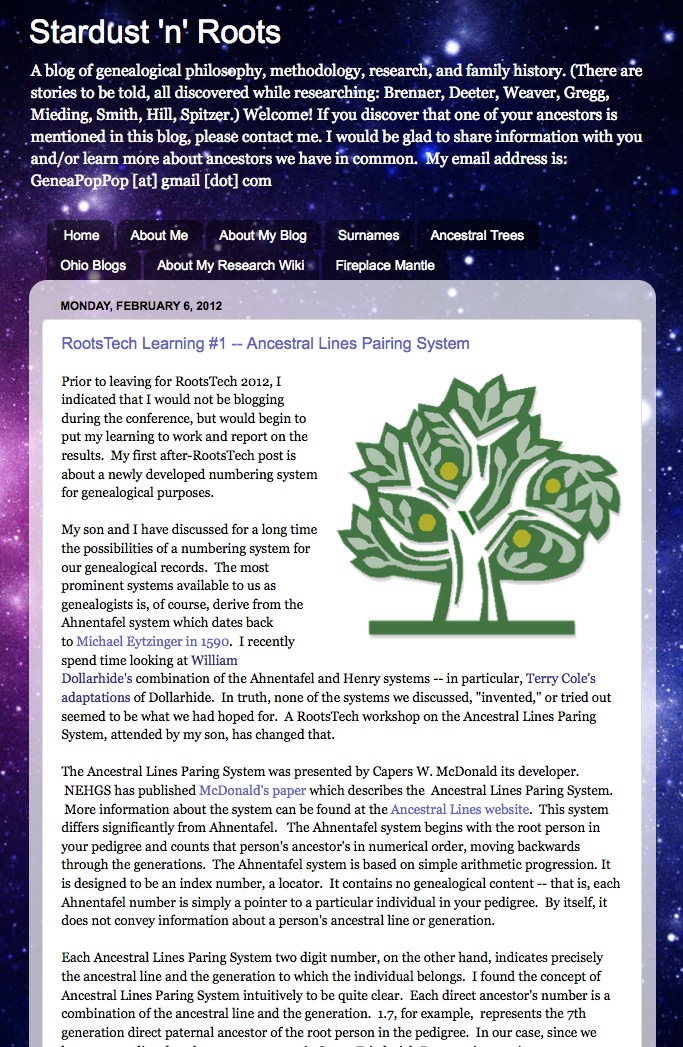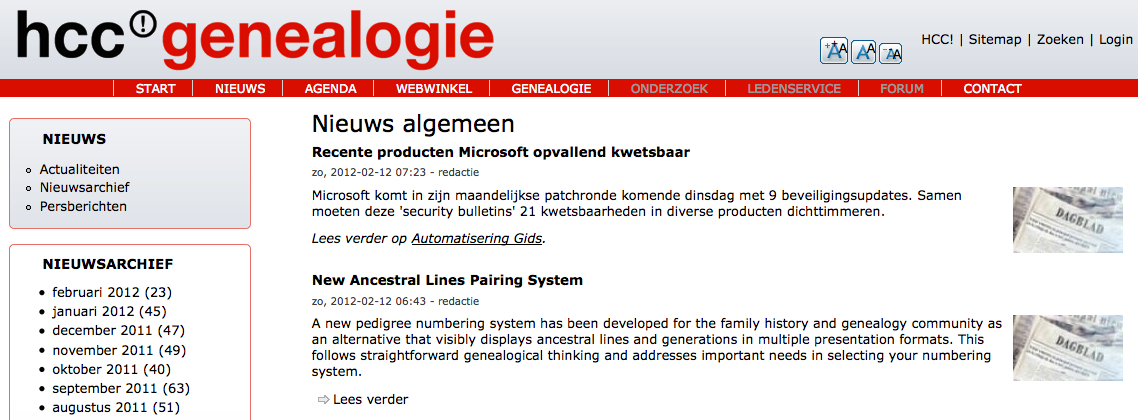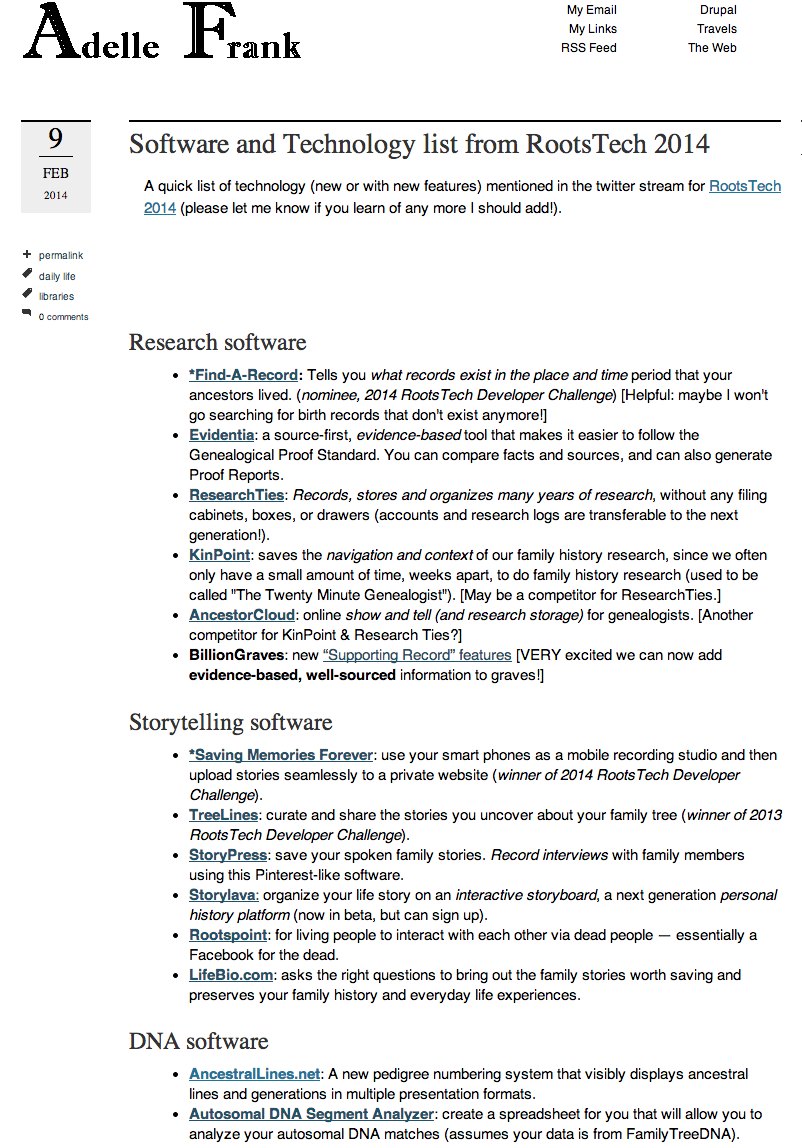There are many reasons to speak up and participate in your online community. You may want to share experiences, insights, suggestions or even questions – perhaps to help others, or to become a better family historian or genealogist yourself. You may want to introduce yourself, find a new colleague, or renew a former acquaintance. You may simply wish to add your own voice to the community dialogue!
The opportunity presented here is to add your ideas, comments, questions or critiques to the discussion of Ancestral and Descendant Lines as a new alternative in numbering pedigrees or descendancies – whether those are your own, or for your clients or audiences.
A sincere effort will be made to keep our information accurate and up to date. However, titles and affiliations are listed as provided at the time of each entry. Any changes to an individual’s affiliation, Web site or email, if provided by them, will be that person’s responsibility to inform us about.
From A Few Websites and Blogs
A site early to feature Ancestral Lines was Dick Eastman’s, as below. The following article is from Eastman’s Online Genealogy Newsletter and is copyright by Richard W. Eastman. It is re-published here with the permission of the author. Information about the newsletter is available at http://blog.eogn.com, which sports a nicely updated format from that below.

Initial comments and replies dealt with several important ideas and concerns for better understanding and using Ancestral Lines. As extended explanations of the design features and intended use of Ancestral Lines (and potentially any new ancestral numbering system) from the initial article, author Capers McDonald provided the following summaries. These are taken verbatim from Eastman’s Online Genealogy Newsletter.
“As mentioned in the article, there’s no question that an Ahnentafel produces adequate results for its intended purpose. Having a single unique number for each direct ancestor is valuable, certainly as a key-person index reference.
“Ancestral Lines is designed as an alternative, primarily to follow genealogical practice and indicate family lines and generations. Both professional and occasional genealogists think and talk using these two terms, since they help communicate personal and temporal relationships.
“The question often asked and being answered is this, ‘How should we number our lines?’ And the best answer, it turns out, for a patrilineal system is to number the lines in an order that enables existing paternal lines and generation numbers to be used to assign each maternal line number as it is paired.
“This approach does not follow an Ahnentafel-type sequence of numbering the lines, however. It has different ideas behind it, as discussed in the NEHGS article. As one consequence, Ancestral Lines generates only one-half the new lead numbers per generation as with Ahnentafel, and these smaller numbers then persist into the most distant past. This provides both a visible connection for the lines as well as fewer and easier numbers to recall. (Of course, this does not mean that those of us who use and understand Ahnentafel numbering would call it “easier” right away. We already speak that first language and are comfortable with it!)
“The underlying math is rightly generating comments, and deserves some follow-up as well. As I read these, it’s the branching calculation that is causing concern (not that we continue the line number and visibly account for generations 1, 2, 3, etc. along those).
“Rather than a hindrance, in the age of computers the math can be thought of as a characteristic that ensures consistency and integrity of the numbers, and is easily programmed. It arises from the natural ‘coupling’ of two parents, just as in the Ahnentafel method. And that is, of course, a fundamental aspect of our biology – which strongly suggests that it could be a useful approach and may even stand the test of time! This then gives rise to working in multiples or powers of two, which provides us fixed numbers to add to paternal lines in each generation.
“Other than from programs, branching ancestral line numbers can readily be checked or learned from a reference chart or table. We may eventually even ‘have an app for that.’ However, believe it or not, they also can be generated without reference to any formula by numbering the lines much like numbering an Ahnentafel (and doing so ‘by hand’ a time or two can be instructive).
“It’s certainly a hallmark of many families, even cultural groups, to repeat given names. And it wouldn’t exactly be the same as for English monarch Edward IV, or his French contemporary, Louis XI — but imagine numbering your many ancestral ‘Edwards’ along the line you mention, as great-grandfather 1.4 Edward, 1.5 Edward… through 1.11 Edward, 1.12 John, then 1.13 Edward…”
A site adopting Ancestral Lines shortly after RootsTech 2012 was Stardust ‘n’ Roots, as follows. It is re-published here, in part, with the permission of the author and is available at http://brennerfamilytree.org/wp/2012/02/rootstech-learning-1-ancestral-lines-pairing-system.html.

This was picked up as a “great read from the genealogy blogs” by Genea-Musings, as follows:

Ancestral Lines made a “Top 20” Webpages list in 2014:

Another site also discussing Ancestral Lines shortly after RootsTech was hcc genealogie, as follows: http://genealogie.hcc.nl/drupal/nieuws/nieuws-algemeen/new-ancestral-lines-pairing-system.

And Ancestral Lines was searchable in Japanese on weblio.

Ancestral Lines made a software and technologies list reviewing RootsTech 2014:

John Ralls was pinch-hitting for Dick Eastman when he commented on his own schedule at RootsTech 2014’s Innovator Summit and provided a link to this Ancestral Lines Website.

Words of Experience and Guidance
Please email ideasandcomments@ancestrallines.net to allow us potentially to add your ideas, comments, questions or critiques to the discussion of Ancestral Lines as a new alternative in numbering ancestral records. Your contribution will be appreciated!
In what must be a “good omen,” the very first respondent providing online reader feedback to NEHGS on the initial Ancestral Lines article submitted the following: Do you understand the system? “Yes.” Advantages over using Ahnentafel? “Yes.” Other comments? “Having researched my family tree for 42 years, I have accumulated many branches. This numbering system will help distinguish the lines.”
Let’s follow that up by reminding ourselves of some very relevant published guidance:
“The selection of a numbering system is one of the key decisions the writer of a family history will make. It should, therefore, be made with care.” — Joan Ferris Curran, C.G., “Numbering Your Genealogy: Sound and Simple Systems,” NGS Quarterly 79 (September 1991), 189, and NGS Special Publication no. 59 (Arlington: NGS, 1992).
“…the Editor…recognizes the value of adherence to standard forms and strongly recommends that anyone contemplating the publication of a genealogy should follow Mrs. Curran’s advice. The advice given here should be followed in most publications, especially when many generations of a family are to be discussed.” — John Frederick Dorman, ed., The Virginia Genealogist 37:1 (1993), 66-67, review of “Numbering Your Genealogy: Sound and Simple Systems.”
“A good genealogist is an organized genealogist. Consistent use of four organizational tools – pedigree charts, family group sheets, research logs and correspondence logs – will help you start out right. While many additional forms are available, these four represent essential building blocks upon which to base your genealogical success. The first two of these forms are critical as they organize basic family information… One of the strengths in using pedigree charts and family group sheets is the ability to develop research plans efficiently. You can easily decide which individual you want to research and plan your work around that goal; you can show a librarian or archivist your chart and succinctly describe your research needs.” — Carolyn Barkley, “Get Organized: Basic Forms For Beginning Genealogists,” online at www.Archives.com/experts/barkley-carolyn/basic-forms.html (July 2009).
“Explore Collateral Relatives / Beginning genealogists often concentrate on just their direct ancestors, wanting to push their family tree ever onward and upward. However, don’t neglect the ‘collaterals’; the siblings, aunts, uncles and cousins of those you are descended from.” — Claudia Breland, “Brick Wall Breakthrough: Follow the Breadcrumbs On & Offline,” online at www.archives.com/experts/breland-claudia/family-history-case-study.html (Nov. 2011).
This website and all images it contains are being used for limited and noncommercial purposes, principally colleague and collaborator communications and shared learning.
